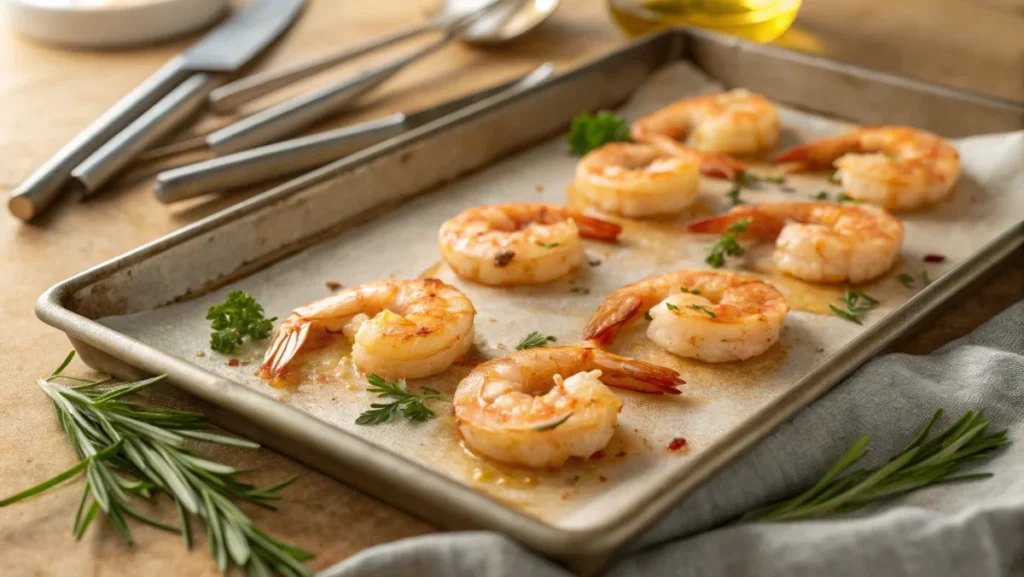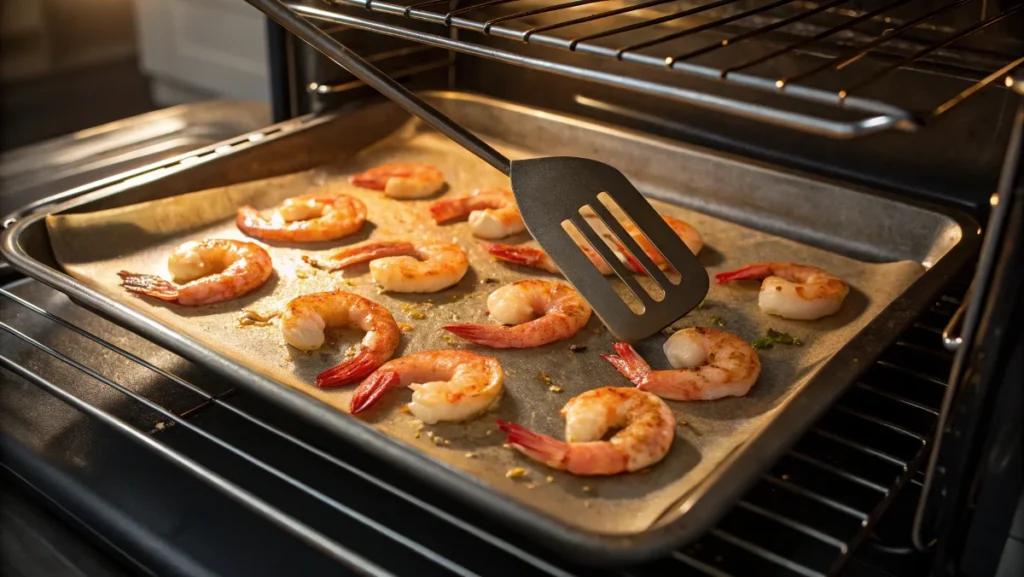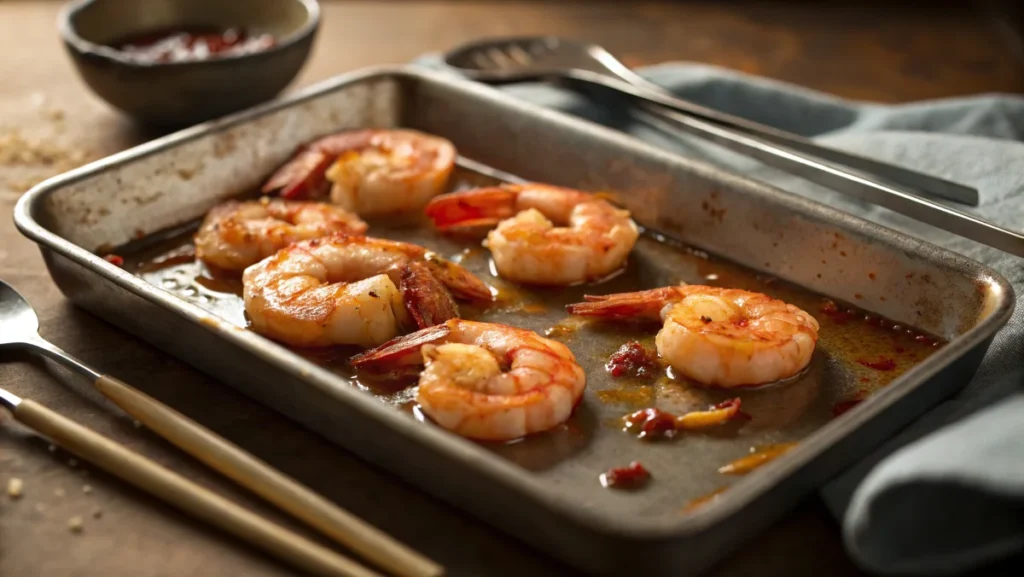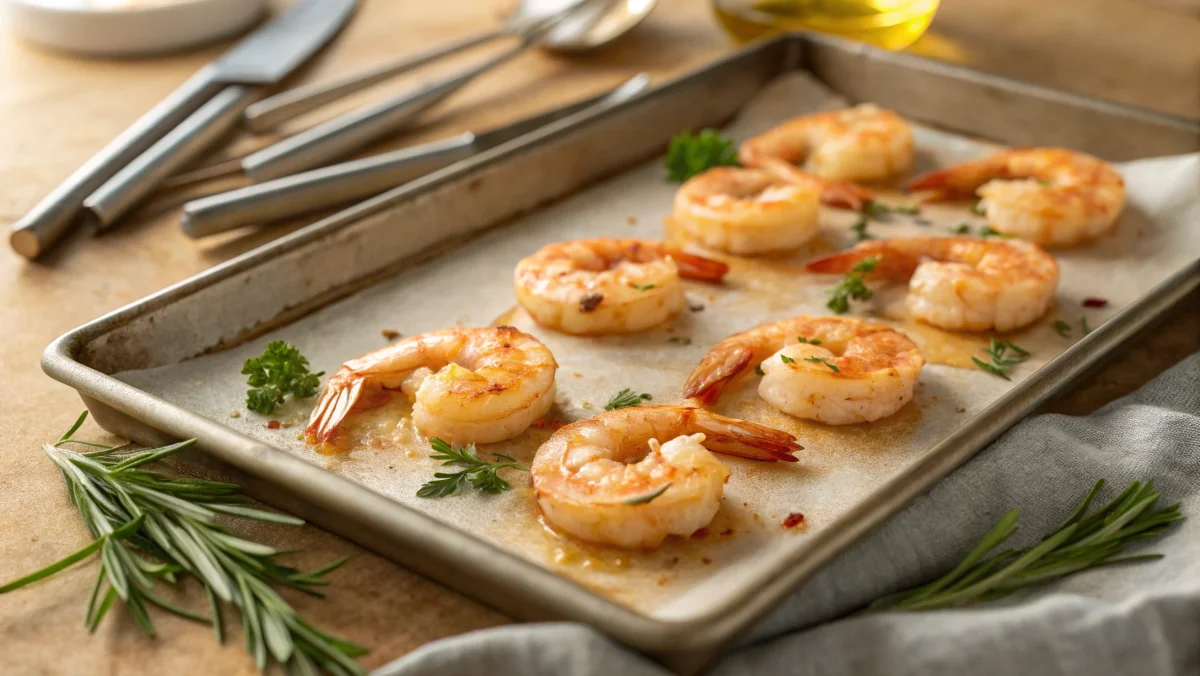Baking shrimp is a simple, delicious way to prepare this seafood favorite, but one question often arises: Do you have to flip shrimp when baking? This seemingly straightforward question can spark a debate among both home cooks and seasoned chefs. While baking shrimp is a quick method to cook this delicacy, the decision to flip them or not can impact the texture, flavor, and overall outcome.
In this article, we’ll explore the baking process step by step, discussing when flipping shrimp is necessary and when it might be best to skip this step altogether. Additionally, we will consider factors such as heat distribution, cooking time, and shrimp size, which all influence how well the shrimp bake. By the end of this guide, you will have a clear understanding of how to bake shrimp to perfection every time. For more insights on achieving the perfect result, check out Best Temperature for Shrimp in the Oven: Tips for Perfectly Baked Shrimp.

Understanding the Process of Baking Shrimp
Before diving into whether or not you need to flip shrimp when baking, it’s essential to understand how the baking process works. Baking shrimp uses dry heat to cook the shrimp, typically in an oven. This method allows the shrimp to retain their moisture while developing a slightly crispy exterior, depending on the cooking technique and time.
The heat in the oven surrounds the shrimp, cooking them evenly from all sides. However, because shrimp are relatively small and delicate, they cook quickly, making it important to monitor the process carefully. You may wonder if flipping shrimp midway through the cooking process ensures that the shrimp cooks evenly on all sides or if it’s better to let them remain undisturbed.
Factors to consider when baking shrimp include:
- Oven temperature
- Shrimp size
- The presence of shells
- Baking method (with or without oil)
These factors can help determine the need for flipping.
Do You Need to Flip Shrimp When Baking?
Do you have to flip shrimp when baking? The answer depends on various elements, including the baking method, oven heat distribution, and the texture you’re aiming for.
In general, flipping shrimp during baking is not always necessary. Since shrimp are small and cook quickly, they may cook evenly without needing to be turned over. For example, if you’re using a convection oven, which circulates air efficiently, heat will surround the shrimp from all angles, leading to uniform cooking. Therefore, flipping the shrimp may not add much benefit.
However, if you’re baking shrimp on a flat sheet pan without using a convection setting, you might want to flip the shrimp to ensure both sides get a similar level of heat exposure.
Key reasons to flip shrimp:
- Ensures even cooking on both sides
- Promotes an evenly browned, crispy texture
- Helps in preventing one side from becoming overcooked
Key reasons not to flip shrimp:
- The oven’s heat may be distributed evenly, eliminating the need for flipping
- Shrimp are small and cook quickly on both sides simultaneously
- Flipping can disrupt the shrimp’s delicate texture

Factors That Influence Whether to Flip Shrimp
Several factors influence whether you should flip shrimp while baking. These factors can range from the type of shrimp you are cooking to the specific baking method used. Understanding these factors will help you decide when flipping is essential and when it’s safe to skip this step.
1. Oven Type and Heat Distribution
In conventional ovens, heat can be uneven, meaning some areas may be hotter than others. In this case, it’s a good idea to flip shrimp when baking halfway through to achieve an even cook. On the other hand, convection ovens circulate hot air, ensuring the heat reaches the shrimp from all angles. As a result, flipping shrimp is less crucial.
2. Shrimp Size and Thickness
The size and thickness of the shrimp also play a significant role. Larger, thicker shrimp may benefit from flipping, as the extra thickness could result in uneven cooking. In contrast, smaller shrimp will likely cook more evenly without flipping.
3. Cooking Method
How you prepare the shrimp before baking can also influence whether you should flip them. For example, if you’re baking shrimp with a breadcrumb crust or a delicate marinade, flipping them may cause the crust or coating to break apart. In such cases, it’s better to let them cook undisturbed.
The Role of Heat Distribution in Baking Shrimp
The way heat is distributed inside your oven significantly affects whether or not you need to flip shrimp while baking. In most conventional ovens, heat is not distributed as evenly as it is in a convection oven, which can lead to uneven cooking. This is especially noticeable when you’re baking shrimp on a flat pan without using oil or a rack.
Understanding heat distribution:
- Conventional ovens often have hot spots, so some shrimp may cook faster than others. Flipping helps mitigate this.
- Convection ovens use a fan to circulate heat, leading to more consistent temperature across the baking surface. Flipping is less necessary in this case.
Regardless of the oven type, the closer the shrimp are to the heat source, the quicker they will cook. Shrimp are delicate, so it’s important to avoid overcooking them, as they can become rubbery.
When Flipping Shrimp Enhances Texture and Flavor
When baking shrimp, oven temperature is crucial. Too high, and they’ll overcook; too low, and they’ll be undercooked. To ensure even cooking, it’s important to flip shrimp when baking. The optimal temperature is between 375°F and 425°F (190°C – 220°C), with 400°F being ideal for a crisp exterior and tender inside.
Additionally, flipping allows both sides to develop a deeper flavor. As shrimp cook, the natural sugars and proteins on the surface caramelize, creating a richer, more intense flavor. If you’re baking shrimp in a sauce or with a marinade, flipping ensures both sides of the shrimp are coated with these flavorful liquids, giving them a balanced taste.
When flipping enhances shrimp:
- Crispiness: Ensures a crisp crust forms on both sides.
- Flavor: Exposes more surface area for caramelization.
- Evenness: Avoids overcooking on one side, promoting a uniform cook.
Advantages of Baking Shrimp Without Flipping
While flipping shrimp can improve texture and flavor, there are distinct advantages to baking shrimp without flipping. For one, it’s less labor-intensive. By simply placing shrimp in the oven without the need for flipping, you reduce the chances of disturbing the delicate shrimp or causing a crust to break apart.
Additionally, baking shrimp without flipping can be ideal for cooking shrimp in a sauce or marinade. In this case, the shrimp will naturally cook in their juices, resulting in a moist, flavorful outcome. By avoiding flipping, you also preserve the integrity of the sauce, which could otherwise get splattered around the pan. This method removes the need to flip shrimp when baking, allowing the shrimp to absorb the full flavor of the sauce.
Benefits of baking shrimp without flipping:
- Less handling of shrimp reduces the risk of breakage.
- Ideal for baking shrimp in flavorful marinades or sauces.
- Reduces the risk of uneven browning.

Optimal Temperature for Baking Shrimp
When baking shrimp, oven temperature is crucial. Too high, and they’ll overcook; too low, and they’ll be undercooked. To ensure even cooking, flip shrimp when baking. The optimal temperature is between 375°F and 425°F (190°C – 220°C), with 400°F being ideal for a crisp exterior and tender inside.
Temperature tips:
- 375°F to 425°F: Ideal for most shrimp dishes.
- Preheat your oven to the desired temperature to ensure consistent cooking.
- Monitor shrimp closely to avoid overcooking, especially at higher temperatures.
Best Practices for Preparing Shrimp for Baking
Proper preparation is key to achieving perfectly baked shrimp. Even if you’re not flipping shrimp, you should take certain steps to ensure that the shrimp cook evenly and retain their flavor.
1. Clean and De-vein the Shrimp
Before baking, make sure to clean and de-vein the shrimp. While some prefer to leave the shells on for added flavor, removing the shells can make it easier for the heat to reach the shrimp evenly. If you choose to leave the shells on, you might want to flip shrimp when baking to ensure they cook evenly on both sides.
2. Dry the Shrimp
Pat the shrimp dry with paper towels. Excess moisture can lead to steaming instead of baking, which will affect the texture and flavor. Dry shrimp will crisp up better and cook more evenly.
3. Season the Shrimp
Seasoning is essential for flavor. Whether you use a simple salt-and-pepper mix or a more elaborate marinade, make sure the shrimp are well-seasoned. If you’re marinating the shrimp, allow them to sit for at least 15 minutes to absorb the flavors.
How to Ensure Even Cooking Without Flipping Shrimp
If you decide to bake shrimp without flipping, there are several steps you can take to ensure even cooking.
1. Use a Baking Rack
A baking rack allows air to circulate around the shrimp, promoting even cooking. This is especially useful in conventional ovens where heat distribution can be uneven.
2. Arrange Shrimp in a Single Layer
To allow for even heat exposure, arrange the shrimp in a single layer on the baking sheet. Avoid overcrowding the shrimp, as this can prevent air from circulating properly.
3. Rotate the Pan Halfway Through Cooking
If you’re not flipping the shrimp, consider rotating the pan halfway through the cooking time to ensure that the shrimp cook evenly on all sides.
Common Mistakes to Avoid When Baking Shrimp
Even experienced cooks can make mistakes when baking shrimp. To ensure the best results, avoid the following common errors:
- Overcooking shrimp: Shrimp cook very quickly, so it’s easy to overdo it. Watch them closely, and remove them from the oven as soon as they turn pink and opaque.
- Underseasoning shrimp: Shrimp can be bland without proper seasoning. Be sure to season them adequately before baking.
- Crowding the shrimp: Overcrowding the pan traps moisture and results in uneven cooking. Always bake shrimp in a single layer with some space between each piece.
Tools and Equipment to Perfectly Bake Shrimp
Having the right tools can make a significant difference in the outcome of your baked shrimp. While you don’t need a lot of specialized equipment, there are a few essential tools that will help you achieve the best results.
- Baking Sheet or Pan: Choose a sturdy, rimmed baking sheet for even heat distribution.
- Baking Rack: A rack keeps shrimp elevated, allowing heat to circulate evenly.
- Parchment Paper: Lining the pan with parchment paper prevents sticking and helps with cleanup.
- Oven Thermometer: Ensures your oven is at the correct temperature for perfectly baked shrimp.
FAQs:
Do you have to flip shrimp when cooking?
No, you don’t always have to flip shrimp while cooking. Shrimp cook quickly, and flipping them can help ensure even cooking on both sides. However, depending on the method (like baking or grilling), flipping may not be necessary if they’re arranged evenly. Just be sure to monitor their cooking time to avoid overcooking.
How do you know when shrimp is done in the oven?
Shrimp is done when it turns pink and opaque. When baking shrimp in the oven, look for a light pink color, firm texture, and the “C” shape. If you’re unsure, flip shrimp when baking to ensure even cooking. However, keep in mind that if they’re overcooked, they’ll become tough and rubbery, so keep a close eye on them toward the end of the cooking time.
What not to do when cooking shrimp?
When cooking shrimp, avoid the following:
- Overcooking: Shrimp cooks very quickly, so keep an eye on them to avoid a rubbery texture.
- Not thawing properly: Cook shrimp directly from frozen for best results, but if thawing, ensure it’s done safely in the fridge or under cold water.
- Using high heat without monitoring: Shrimp cooks best at medium to medium-high heat; high heat can lead to uneven cooking.
- Leaving the shells on (if preferred peeled): If you’re serving shrimp without shells, peeling them beforehand will make eating easier.
Should you cook shrimp with or without tails?
It depends on personal preference and the dish you’re preparing. Cooking shrimp with the tails on can enhance flavor and presentation, but it requires peeling before eating. If you’re serving shrimp in a dish where ease of eating is a priority, it’s better to remove the tails beforehand.
Conclusion
In conclusion, deciding whether to flip shrimp when baking depends on factors like oven type, shrimp size, and your chosen method. While flipping is optional, it often enhances texture and flavor. The key to perfectly baked shrimp lies in maintaining the right temperature and avoiding overcooking. For further guidance on seafood cooking temperatures, check out Is salmon 140 or 145?.

